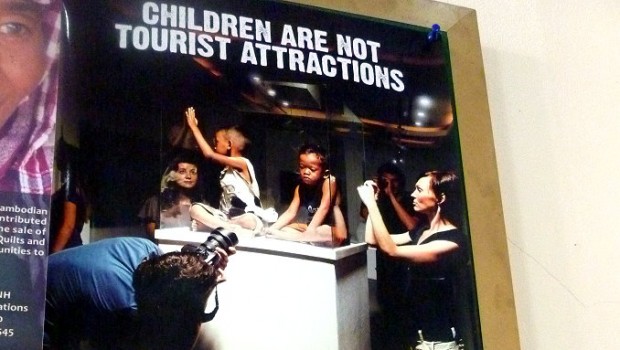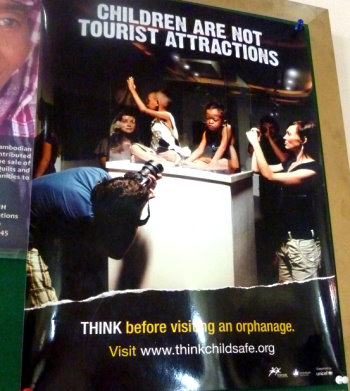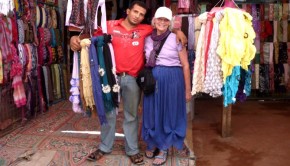Children Are Not Tourist Attractions
I have a gazillion chores to do here as I prep to leave my dear Shangri-la in Dalat in but a few days, and head to Nepal, Borneo, and… ?
BUT in researching my Nepal trip I discovered a most profound post that I simply HAD to drop everything else and repost here. Buried on page 11 of the Lonely Planet Thorn Tree Forum thread entitled: “Indian Subcontinent FAQ”, I present it here in its supremely thoughtful entirety.
I’ve long been acutely aware of the grim problem of “orphanage tourism” in many developing countries (not just in Nepal), but this post pretty much says it all. I don’t normally hop on a soapbox here at TL, but in this case… do please spread the word to travelers of all flavors. The message here bears repeating, and repeating, and repeating.
On Children’s Homes In Nepal
I am writing this because I am concerned by the tourism that has developed around visiting children’s homes in Nepal. I have been involved with children’s homes in Nepal since 2005 and have experience dealing with both child traffickers and truly amazing NGOs. I want to make sure that people have proper information about the real situation before visiting or donating money to children’s homes in Nepal.
Background:
The first thing is to notice that I did not use the word orphanage. True orphanages, particularly in the Kathmandu Valley, are not all that common. Most children are IDPs, or internally displaced persons. That is the technical term for someone who has been displaced from their home due to conflict but has not left the country- essentially it’s a refugee who still remains in their country of origin. Many of the children in the KTM Valley are from areas that were “Highly Maoist Affected” during the civil war. The Maoists would go to families and demand they pay a tax. Failure to pay this tax would result in the child being taken away and forced into the army- the Maoists were notorious for their use of child soldiers. Many families were unable to pay the tax, but fearful for their children. This is when a “respectable business man” would come along and offer an alternative. He would promise to take the children and put them into boarding schools in the safety of the Kathmandu Valley, the last stronghold of the king. Traffickers promise nutritious food, good education, and a future that is still largely unattainable in most places outside of the valley even today. Parents pay this man a fee and death certificates are often forged. The kids are taken to the valley and often dumped there in truly squalid conditions, many will be sold into domestic servitude in Nepal, brothels in India, or forced to beg on the street. They become easy pray for pedophiles. It is likely that there are currently 15,000 kids in this position in Nepal.
Orphanages as Businesses:
The truth is that the vast majority of children’s homes in the Kathmandu Valley are run as business. It is an equation by the owner of how he can get the most money out of the venture rather than protecting the welfare of the children. Nearly every shop owner in Thamel can tell you how they are connected to an orphanage. It should be noted that the people who hold guardianship over the kids are generally referred to as the orphanages “Owner”. The equation for the owner is how they can get the most money out of the home. This means that nearly nothing is provided to the children- children often obtain food through the kindness of neighbors, through begging, or they slowly starve.
This is the place where foreigners come in. One of the best ways to get money from your orphanage is through aid. Well intentioned but misguided charities and tourists see starving, sick children wearing rags and living in squalid conditions and feel compelled to donate money or other goods. They money normally goes directly into the orphanage owners pockets, hardly any will be spent on the children. Moreover, this donation of aid creates an economic incentive for the owner to keep the children looking sick, starving and in squalid conditions because they have now learned that foreigners will easily give aid to kids who look poor-off and it is far more profitable than actually providing the kids with care. These donations of foreign aid provide incentives for child traffickers to abuse children. PLEASE DO NOT BECOME A PART OF THIS PROCESS.
Guidelines for providing help:
That said there ARE good children’s homes in the valley that do deserve your support. The problem is how to tell the difference. I would ask that you ask yourselves these basic questions before donating to a children’s home.
1) Do the children appear to be generally in good health? Do they look malnourished? Are there signs that sick or hurt children are being cared for?
This is by far the most important one. Look at the children’s skin. If the kids are covered in open sores that is a pretty good indication that they are not being properly cared for. Yes, children all over the world like to run around and play and will get all sorts of cuts and scrapes, but there is a difference between normal wear and tear and what I am describing. Open wounds, boils, large fungal infections, scabs on the face, and seriously dry and cracked skin are often signs that the kids in poor health. Does it appear that several of the kids have distended stomachs and thin arms? This is another bad sign. Do you hear coughing and children with wet lungs? Do you see pus coming out of children’s ears? Both of these might be found even in good homes, but the difference is the number of cases and weather or not they show signs of being treated. Asking the kids or the manager if they have seen a doctor is generally a poor way of fact finding. Ask to see that child’s medicine.
IF THE KIDS LOOK GENERALLY IN POOR HEALTH DO NOT GIVE TO THIS HOME!
I know it is difficult to avoid giving money to children who are so clearly in need, but please keep in mind that the money you give will not be going to the kids in this instance. Responsible organizations and children’s homes do not take on more children than they can afford to care for, if you provide money to a home where the kids are obviously in bad shape, all you do is create an incentive for the owner to abuse more children.
2) Are the kids in school?
All of the kids over 3 should be in school. Nearly all schools in Nepal have uniforms. If you see the kids doing homework or see the uniforms this is a good sign. Responsible caretakers ensure the education of the children they support, if the kids are not in school then the owner is showing that they don’t really care about the children’s welfare.
3) What kinds of conditions do the children live in?
This can be a hard question for a foreigner to answer because what is shocking to us can actually just be normal and completely fine. Multiple children in a bed is no cause for concern and is a normal practice. however by Nepali law boys and girls should not be sharing the same room in a home. Any home with a bunch of kids in it is going to get a bit dirty and Nepal can get generally dusty in the dry season, the question is does it look like someone regularly attempts to clean the home? Don’t expect refrigeration. However, there should be bathroom facilities. That can be in the form of an outhouse or squat toilet, but it should be closed. Open cess pits, are a bad sign. While bathrooms in children’s homes can smell awful even in good homes, a good home will ensure that they are generally hygienic. Does the building look sturdy or are bits of it collapsing? I think you get the idea. Essentially kids should not be living in squalor.
There is however a counter point to this. Some bad places can make shows of their facilities. If it looks like all they money has gone into a facility but not much has been spent on the kids, this is also a bad indicator.
4) Are the kids dressed in rags?
Even good homes rely on ill fitting donations and kids will create all sorts of wear and tear in their clothes, but this is different than kids who are dressed in rags. Signs that clothes have been mended are good, tatters and really ill fitting clothes are bad. Also, kids should be dressed in weather appropriate clothes. It gets cold in the valley at night in the winter and indoor heating will likely not be found even in good homes. Children rely on their clothes to keep them warm. If the owner hasn’t provided them with the basics to keep warm, it’s neglect.
5) Do the kids generally seem happy? Or do they hang back, or hide in fear. Do they try to talk with you and interact with you?
Kids are resilient and often try to make the best out of even bad situations, so even kids in bad homes might seem happy and playful, but it is rare for a children in a good home to demonstrate fear. A foreigner is a subject of curiosity, if the children seem truly reticent (I’m talking more than basic shyness) to speak with you it is a very bad sign.
I know what I am saying is really basic, but it has always been shocking to me the willingness of NGOs and tourists to hand over money and goods directly to orphanage owners who are clearly neglectful. Media in the west has used pictures of children with distended bellies and flies in their eyes to tug at our heartstrings so that we will donate, so these are the images foreigners most often associate with people deserving of help. Please only support homes that have demonstrated that put their money into the kids. Keep in mind that responsible homes do not take on more children than they can support. Also be aware that the distinctions can be hard to see; all I ask is that you critically think about any home you’re considering supporting and exercising your best judgment.
On Orphanage Tourism:
Finally I wanted to talk about orphanage tourism. Over the years I have seen and met a lot of people who talk about wanting to visit an orphanage in Nepal. Somewhere along the way I think we have romanticized the idea of children in poverty particularly in rural settings. This is truly disturbing to me. The first thing I want everyone to remember before they visit a children’s home is that it is these children’s home. These are real people with real hopes, real desires, real dreams, just trying to go about the business of growing up. THEY ARE NOT TOURIST ATTRACTIONS Treating children as tourist attractions is dehumanizing. I know my kids found it degrading and upsetting. The kids in children’s homes have been through a lot. Either they’ve lost one or both parents, or they are refugees. In either case they have gone through enough without foreigners coming in and remarking to themselves about the conditions in which they live or their physical appearances. Everest is a tourist attraction, Pashupati is a tourist attraction, Boudha is a tourist attraction, anyone on this cite can give you a list of tourist attractions for your itinerary, a children’s home should never be thought of a tourist attraction.
Orphanage volunteering is another issue. In general follow the guide lines listed above about cites, though i am the first person to recognize there are extenuating circumstances. Many good homes benefit from volunteers. However every volunteer should realize that the person benefiting the most from volunteering is themselves. Before starting a volunteer position in a children’s home, ask yourself if you will be doing the kids more harm than good. Children easily become attached to volunteers and the constant stream of people in and out of their lives can cause serious psychological harm. It can be seriously upsetting to the children. Volunteering in a home is a commitment to the kids. You should only be volunteering if you are willing to make that commitment. If your orphanage is just a base for your tourist actives like trekking or sightseeing, please just make a contribution instead. Additionally if you can only make a short term commitment (I’d say anything under 2 months, though truthfully the way visa situations work all voluntary work in orphanages is short term) please seriously consider donating the money you would have spent instead.
Alright, that was my treatise on children’s homes. All I ask is that you use your best judgment and make your decisions based around what’s best for the kids.
Posted March 2011 in Lonely Planet Thorn Free Forums by an American lass by the username of xtemp
xtemp’s LP profile:
Traveler with a serious case of wanderlust. I am originally from the Chicago Area then moved to DC for school. I managed an orphanage for an extended period of time in outside Kathmandu during the height of the revolution in 05/06 before college. A little older and a little wiser I returned to south asia to live, work, and study in Nepal and India in 2008/2009. Currently plotting a return to the region.







 Off-the-beaten-path travel is my passion, and I’ve always lived life “like a kid in a candy store” – eager to sample as many flavors as I can. Indeed, my life motto has long been:
Off-the-beaten-path travel is my passion, and I’ve always lived life “like a kid in a candy store” – eager to sample as many flavors as I can. Indeed, my life motto has long been:









